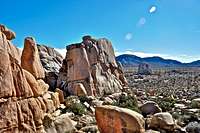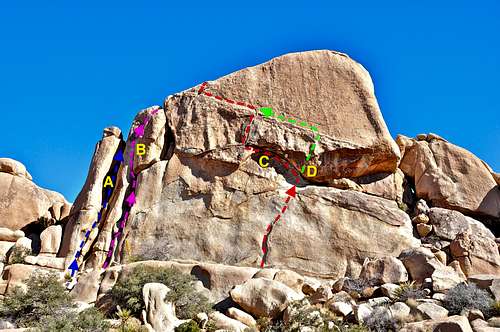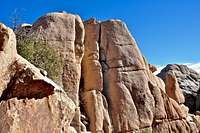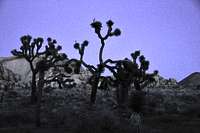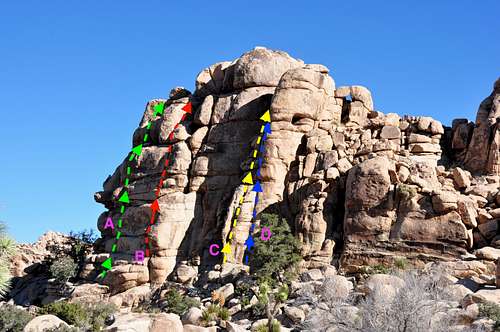-
 4759 Hits
4759 Hits
-
 85.87% Score
85.87% Score
-
 21 Votes
21 Votes
|
|
Area/Range |
|---|---|
|
|
34.01858°N / 116.16614°W |
|
|
Trad Climbing |
|
|
Spring, Summer, Fall, Winter |
|
|
4000 ft / 1219 m |
|
|
Overview
| Note: Joshua Tree National Park is tremendously large and includes thousands of rock formations. The purpose of this page is to bring some sense of organization to many "Mountain & Rock" pages I have posted for the past two years. This particular page may be considered as a mini "Area & Range" page that will be attached to the main Joshua Tree page as a child. |
Direction to Steve Canyon Area:
from the west entrance to Joshua Tree National Park, drive 8.3 miles on Park Boulevard to a turnout about quarter of a mile before reaching Intersection Rock parking lot. Looking on the opposite side of the road, in the northeasterly direction, you will see Watanobe Wall to the west of the narrow and steep Steve Canyon. Park in the turnout and and head for Steve Canyon.
Sidewinder Rock
Sidewinder RockBeing within a minute walking distance from the Park Boulevard and a few hundred yards from Hidden Valley Campground, Sidewinder Rock was noticed and climbed as early as 1972. The young and talented John Long established one of the hardest routes on this rock, and in fact in all of Joshua Tree at that time. This route, which is still one of the most sought after routes for the up and coming climber, is called Jumping Jack Crack, rated 11a.
It was not until 1974 that the most famous route, Sidewinder, on this rock was established. At that time, the first ascent party rated the difficulty at 5.9+. Through the years the route got plenty of traffic and the rating was increased to 10b. The thin face above the initial flake became the crux of the route and deserved a 10b difficulty rating. In the more recent years and decades some variations to the start of Sidewinder have been done. These variations are much more difficult and and don't see as much traffic as the original start.
In contrast to the west face, the east face of Sidewinder Rock is not nearly as distinct and popular. The east face, very rarely visited, is comprised of columns separated by wide cracks and stacked boulders on its north end. The large stacked boulders of the north end make for a convoluted and not so easy route for descent.
Grain Surgery Wall
Grain Surgery WallThe easiest, but not the most enjoyable, route on Grain Surgery Wall is up a prominent chimney that divides the wall into two halves. The most popular route is located on the left half, and it's the climb that the formation was named after. This route is named Grain Surgery, rated 10b. This route offers the two mediums you need to be good at to climb in Joshua Tree- Crack climbing and face climbing. Another route that is highly recommended is located on the right half of this formation. This route is called The Decompensator of Lhasa, rated 10c. This route also starts on a crack for the first half of the route then transitions to bolt protected face climbing to reach the top. If you are not into leading 5.10s, there is a fun easy route for you. This route, Deflowered, rated 5.6, follows a wide crack/chimney located a few feet to the right of the central chimney. More....
Super Roof Wall
Super Roof WallSuper Roof Wall is a rock formation in the Steve Canyon area of Joshua Tree National Park, California.
Super Roof is located within walking distance of Hidden Valley Campground. This is a crowded neighborhood with famous and popular formations such as Intersection Rock, Old Woman and The Blob to name a few. Most people are busy moving from to climb to climb that they just don’t bother to really take in the views offered from this vantage point. For example you may have never seen the west face of The Blob. You get the best view of that on your approach to the mouth of Steve Canyon. You also get a bird’s eye view of the mighty Intersection Rock from the base of Super Roof. It’s a good idea to scramble to the top of Steve Canyon to a notch where you get a view of the back side of Hidden Valley Campground and a large portion of an area known as The Outback.
Super Roof Wall is named after its most famous route Super Roof, rated 5.9, is the impressive overhang half way up the wall itself. When you scramble up the steep and narrow Steve Canyon you get to pass by a number of famous routes such as Sidewinder to your right, The Orc to your left and Grain Surgery directly across from your main objective, Super Roof. By the time you reach the top of this short and rocky canyon, you are treated to the view of one of the most impressive overhangs in all of Joshua Tree. This is Super Roof. More....
The Orc Wall
The Orc WallWatanobe Wall
Watanobe WallWatanobe Wall is a rock formation in the Steve Canyon area of Joshua Tree National Park, California.
I described in some detail the area known as Steve Canyon in my page on Super Roof Wall. In contrast to Super Roof Wall that is east facing and inside, Watanobe Wall is west facing and just outside of Steve Canyon. This wall is clearly visible from Park Boulevard, the main artery running west to east in the park. Steve Canyon and Watanobe Wall have a prime location being very close to the huge parking lot, phone and bathroom facilities of (Intersection Rock) area, yet far enough to give you some sense of privacy. It is unlikely that you receive many spectators while climbing on this formation.
Watanobe Wall was named after the most popular and the original route on this formation, Watanobe Wall, rated 10a. This route is truly one of the best of its type and difficulty rating in Joshua Tree. If the names Tobin Sorenson, or Guyzo mean anything to you, they did the first ascent of this route. A few other climbers who established routes on this formation were none other than legendary figures like Herb Laeger, Alan Bartlett and Santa Barbara’s own, Dave Black.
The west face of Watanobe Wall is divided into two main areas, the left side and the right side. The left side, being a single unbroken piece, is the more prominent of the two and contains the original route, Watanobe Wall route. The right side also has its own share of quality routes such as, Season Opener, 5.8 and Come-N-Do-Me, 10b. The left side sits atop huge boulders, but the base of Watanobe Wall route is flat and not very large. The right side belay areas are mostly in the shade of trees and boulders, but not as aesthetic as the base of the left side.
To descend you have at least two options. The first option is to climb to the top of the formation and look for a set of anchor bolts atop the east face. These bolts will bring you down to the base of a very popular climb called Candelabra. Please be carefull with the huge flake that constitutes the middle section of Candelabra. The second option is to go left from the top of Watanobe Wall to gain the notch that separates this formation from the formation containing Super Roof Wall. From the notch descend easy second and third class rocks down Steve Canyon passing by the base of Sidewinder formation. more...
The Hot Tub
The Hot TubThe routes on the west face, left side as viewed from the base, of The Hot Tub are mostly crack systems, therefore gear protected. To descend these routes walk left, south, on low angle ledges and around boulders to the base. The routes of the right side, south face, of this formation, on the other hand, are mostly on a face protected by a few bolts supplemented by gear. They all reach a two bolt anchor for belaying or to rappel from.
One of the best routes on The Hot Tub is Elixir, rated 10a, which reaches a great ledge with an anchor. This route starts to the right of a block and follows a line of three bolts past some horizontal cracks. It's best to supplement the bolts with your own protection. A bolt anchor on a big ledge will welcome your arrival at the end of the climb.
To the right of Elixir, you will find a wide crack, The Dharama Bums, rated 5.8, requiring large cams for protection. This is not the most enjoyable route on the formation. Immediately to the right of this route, you will find the best route on The Hot Tub. This route is named Amanda, rated 10a. Amanda follows a line of bolts past a few horizontal cracks. Take a standard rack to include some small to 2.5 inches to supplement the bolts. This route has its own anchor high up on the face to rappel from. Going to the very top is optional. more...
Cereal Rock
Cereal RockThe nature of Cereal Rock is blocky with tier system. There are wide horizontal crack systems separating the short faces and some discontinuous vertical cracks. On the left formation, the routes follow these short faces and sections of cracks. The best and more continuous cracks are found on the middle formation to the right of the prominent chimney/gully and on the right side/northern formation. There are a few more difficult routes in the 5.11 range on Cereal Rock, but the majority of the route are more moderate in the 5.7 to low 5.10 difficulty range. Two of the best routes, Alfalfa, rated 5.8 and Quaking Oats, rated 10a are located on the middle section of Cereal Rock.========================================================================================
Select routes of Cereal Rock, West Face | |
| A | The Oat Route, 5.8, standard rack |
| B | Raising Bran, 5.8 standard rack |
| C | Alfalfa, 5.8, standard rack |
| D | Quaking Oats, 10a, standard rack |
| E | Morning Chunder, 5.7, Standard Rack |



